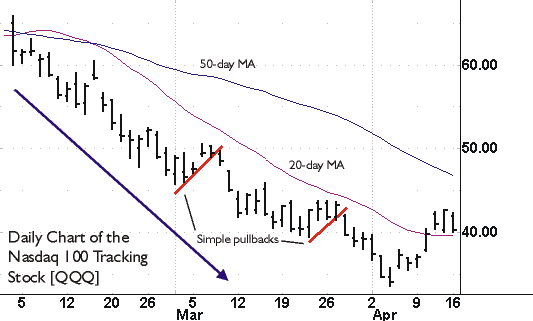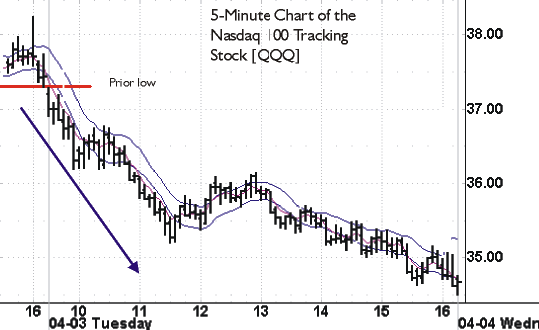Why More And More Traders Are Trading The QQQs, Part I
Do you ever watch
the stocks you are trading
languish
while the rest of the market goes up? Or worse, even drop, contrary
to the direction of the index? Ever find some great shorts that don’t seem to
reach the trigger point, on a day the market goes in the tank?
Perhaps all you need is an insurance
policy — in the form of the Nasdaq 100 Index Tracking Stock
(
QQQ |
Quote |
Chart |
News |
PowerRating),
known affectionately as the Q’s. With the Q’s, you don’t need to pick individual
stocks, and it is easier to track the 100 stocks that comprise the index, if you
choose to trade them (as many traders do) since the institutions track the
issues as well. If you are not trading the Q’s, you should introduce this
vehicle into your trading repertoire. The many advantages of the index tracking
stock include:
- It is often
easier to anticipate the future direction of the index as a whole than
individual stocks
- Mirrors the
action of the index, and moves in a similar manner to the Nasdaq 100 futures
- Less capital
required to trade than a full-size futures contract
- Unlike
individual stocks, the uptick rule does not apply, making shorting them very
easy
- Over 70 million
shares trade daily on average, making them very liquid
But before we get into the advantages
in greater detail, let us first obtain a really good understanding of what the
QQQ is.
What is it?
Although the
Nasdaq 100 index was formed in 1985,
the tracking stock did not begin trading on the American Stock Exchange until
March 10, 1999. The index is made up of the 100 largest and most actively trades
issues listed on the Nasdaq Stock Market. It reflects the Nasdaq’s largest
companies across major industry groups, including computer equipment, software
and services, telecommunications, and biotechnology, for example. In order to
limit domination of the index by a few large stocks, the index is calculated by
using a capitalization weighted method. This capitalization weight distribution
is evaluated on a quarterly basis and is rebalanced, if necessary. So what is
the QQQ exactly? It is a unit investment trust that contains the same underlying
securities that comprise the index itself. It simply trades in the same manner
as any common stock and can be traded throughout the session on the AMEX.
Advantages
It is often much easier to track and
anticipate the future direction of the Nasdaq 100 or its tracking stock than to
sift through the thousands of stocks listed on the three exchanges. For example,
take the simple strategy of trading pullbacks within a trend.

Back in March, swing
traders were able to catch not one, but two moves of more than 7 points each by
simply shorting when the Q’s resumed their downtrend after pulling back from
their low. This would have required about 30 seconds (if that) of looking at the
daily chart to spot these patterns.

Daytraders can also make
use of this instrument in their trading, as a simple continuation short below
the prior day’s bottom price yields a 2 point profit.
No
Need To Wait For An Uptick
One
of the biggest advantages of trading the Q’s as opposed to common stocks is that
when entering a short position, the uptick rule does not apply. This
means that the tracking stock, and its cousins the Spiders
(
SPY |
Quote |
Chart |
News |
PowerRating) (S&P
500 tracking stock) and the Diamonds
(
DIA |
Quote |
Chart |
News |
PowerRating) (Dow Jones Industrial
Average tracking stock) does not have to trade at a higher price before you can
get filled on your short position. In this manner, they trade the same as
futures contracts, in that when you are short, you are filled at whatever the
issue is trading when your short order is executed. This is important, because a
fast-moving stock, even when you have called the proper direction, may slide as
much as 1 point — or even more — before the first trade at a higher price
takes place.
How
Big Is Your Account?
While
some traders choose to trade the stock index futures contracts of the Nasdaq
100, this requires a large amount of capital in one’s account. The
initial margin on the Nasdaq 100 futures is around $48,000 per contract, while
500 shares of the QQQ would run you in the area of $11,250 using 2-to-1 margin,
or less than 25% of the capital outlay. While it is true that the futures offer
greater margin, and therefore greater potential return, it should also be
remembered that the potential for loss is also multiplied in the same fashion.
Traders who are not familiar with trading either futures or e-minis may be more
comfortable with trading a vehicle that is more familiar.
Liquidity,
Liquidity, Liquidity
The
liquidity of this instrument is another great reason to trade the Q’s as opposed
to the futures or e-mini contracts. With
an average daily volume of over 74 million shares, the tracking stock blows away
the volume of both the big contract (around 25,000 traded per day) and the
e-mini (the average is around 170,000 per day). So what does this mean to you as
a trader? What it translates to is for the most part, better fills, since there
are more sellers when you buy and vice versa, whereas trading the futures is
more likely to be fraught with bigger spreads and worse fills due to the lesser
liquidity. Even the e-mini and its electronic matching of buyer and seller,
exists in a less liquid environment since there are less contracts changing
hands daily.
In conclusion, the QQQ is
a very versatile trading instrument that every trader should keep in his or her
arsenal for the times when they may have lost their focus, feel that they may
have a better grasp of the index than individual issues, or for those who are
not able to trade on a full time basis to spot profitable trading opportunities
in the short amount of time they have to allow for chart study each evening. The
Chicago Board Options Exchange (CBOE) also lists options on the Q’s, so there
are also strategies to employ in that area.
In
Part II of this
series, we will go into several different strategies you can use that some of
the TradingMarkets contributors utilize in their trading.
For The Best Trading
Books, Video Courses and Software To Improve Your Trading
